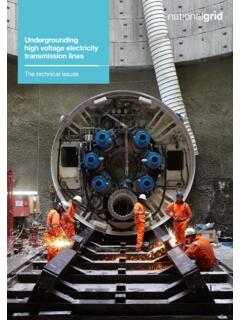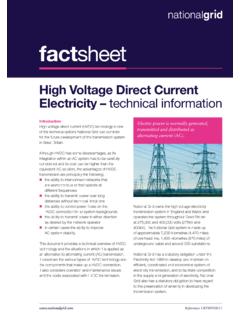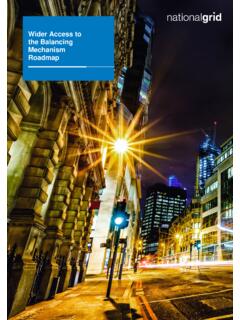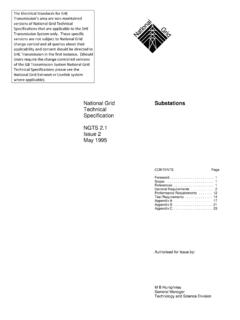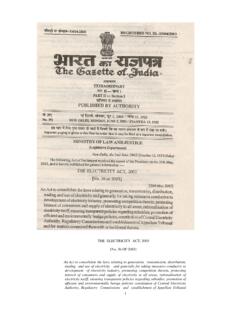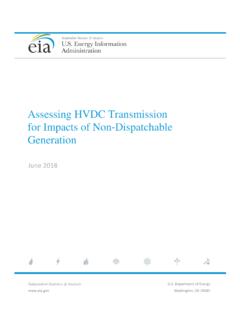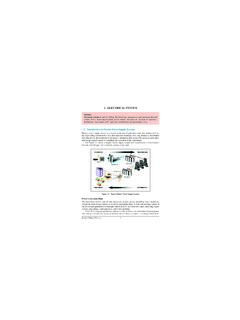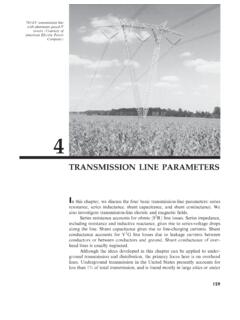Transcription of Planning and amenity aspects of high voltage electricity ...
1 Development near overhead linesPlanning and amenity aspects of high voltage electricity transmission lines and substationsContentsThis document provides information for Planning authorities and developers on National Grid s electricity transmission lines and substations. It covers Planning and amenity issues, both with regard to National Grid s approach to siting new equipment, and to development proposals near overhead lines and we are and what we do 3 Overhead lines and substations 5 Consent procedures 6 amenity responsibilities 7 Schedule 9 Statement 7 Environmental Impact Assessment 8 Routeing of overhead lines 9 Siting of substations 10 Development near overhead lines and substations 11 Safety aspects 12 Maintenance 12 Visual impact 13 Noise 14 Electric and magnetic fields 15 Other electrical effects 16 Development plan policy 18 Appendix I 19 Glossary 19
2 Appendix II 21 Main features of a transmission line 21 Appendix III 23 Safety clearances 23 Contacts and further information 272 Who we are and what we do electricity is generated at power stations around the country. These power stations use a variety of fuels - principally coal, gas, oil, nuclear and wind - to generate electricity , and the stations are generally sited to be close to fuel and cooling water rather than to be near centres of demand. electricity is then transmitted from the power stations through a national network of electricity lines which operate at high voltage .
3 National Grid owns the electricity transmission network in England and Wales and operates the electricity transmission system throughout Great Britain. Local distribution companies then supply electricity at progressively lower voltages to homes and businesses. This transmission system which operates at 400,000 and 275,000 volts (400kV and 275kV) is known as the national grid and covers some 4,500 route miles of overhead line , 420 route miles of underground cable and more than 335 substations. The system, which connects the electricity generators power stations with the networks of the local distribution companies, also connects with some large industrial customers who, by reason of their size and technical characteristics or location, are directly connected to the transmission the electricity Act 1989 National Grid is the holder of a transmission licence.
4 It is required in this capacity to develop and maintain an efficient, coordinated and economical system of electricity transmission and to facilitate competition in the supply and generation of electricity . National Grid s electricity transmission virtually all other commodities, electricity cannot be stored in bulk until it is needed; it has to be generated in the right quantities, at the time it is needed. The vast majority of generating capacity in England and Wales is connected by National Grid s transmission system.
5 This enables the operation of power stations to be coordinated, offering potential benefits of reducing the amount of spare generating capacity and generating reserve needed, and the ability to select power generation to supply the needs of the energy industry is currently going through a period of significant change resulting in a multi-billion pound investment programme. This will encompass small and large scale electricity generation and substantial investment in energy networks to replace and upgrade ageing assets, construct new infrastructure to connect and efficiently deliver new energy sources, as well as maintaining the levels of safety and reliability to which everyone has become accustomed.
6 This note describes National Grid s amenity responsibilities. It briefly sets out both the amenity aspects which National Grid takes into account in siting new electricity lines and substations, and the amenity aspects which are relevant to proposed development near National Grid s electricity transmission equipment. The note goes on to explain these considerations in more detail, which we believe developers and local Planning authorities may wish to take into lines and substations An electricity line consists of either an overhead line or an underground cable, or both.
7 A typical National Grid overhead line route uses three main types of lattice steel tower (or pylon). These are: suspension towers which support the conductors on straight stretches of line ; deviation towers at points where the route changes direction; and terminal towers where lines terminate at substations or are connected to underground II illustrates these Grid s substations are necessary for the efficient operation of the transmission system, for the specific role of switching circuits or transforming voltage .
8 They are normally sited between power stations and the transmission network, and between the transmission network and the local distribution companies networks. They can be sizeable developments, and including connecting terminal towers, can occupy up to 20 hectares. However, advances in technology means that the equipment located at substations is now more compact than that of the 1950s and 1960s when many of the existing substations were built. Hence new substations are considerably smaller in size, both in height and area covered, and in certain circumstances, can be sited inside a building which resembles an industrial unit.
9 Substations are usually contained within steel palisade fencing to ensure public safety, and the structures, excluding towers, are not usually more than 15m in height. Road access is necessary for staff, and for the transport of equipment during construction, maintenance or repair. Very occasionally, transformers or other very large items of plant may need to be moved into or out of sites as abnormal indivisible Grid is a statutory undertaker under the Town and Country Planning (General Permitted Development) Order 1995.
10 The Order grants Planning permission for certain defined classes of development. National Grid therefore has certain rights to carry out development under the Order without the need for Planning permission from the local Planning authority. This permitted development relates primarily to development in existing substations, on operational land and to underground cables. New substations or major extensions to existing substations may require Planning permission from local Planning construct a new overhead line in either England or Wales, National Grid requires formal consent, under section 37 of the electricity Act 1989, from the Secretary of State for Business, Enterprise and Regulatory Reform, unless the new line is across land owned and occupied by the company.
